|
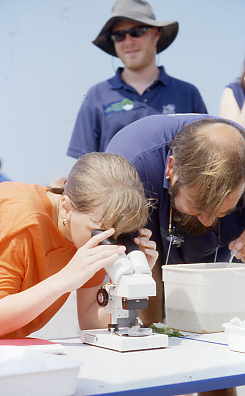 Kids
can make their own plankton nets if time- this could be done in the classroom
before hand, If not use nets provided at the centre. With the rangers, go out to
the sea and trawl for plankton in the shallow waters. A ranger will go and do a
deep plankton trawl. Then we look at everyone’s catch underneath the
microscopes, and look at the different things that the ranger caught in the deep
water. Kids
can make their own plankton nets if time- this could be done in the classroom
before hand, If not use nets provided at the centre. With the rangers, go out to
the sea and trawl for plankton in the shallow waters. A ranger will go and do a
deep plankton trawl. Then we look at everyone’s catch underneath the
microscopes, and look at the different things that the ranger caught in the deep
water.
The rangers assist the
children trawling for plankton in the shallow waters. At the same time a ranger
will be trawling in deeper water, still in view of the children so they can see
how it is done. Everyone’s catch is then examined under the microscopes where
the microscopic mini beasts can be identified. The opportunity is also given to
design your own mini beast.
Investigate the crazy
and bizarre world of the microscopic mini beasts found in the sea! The rangers
demonstrate how to trawl for plankton. Everyone’s catch is then examined under
the microscopes. The opportunity is also given to design your own mini beast.
Aims of Activity
 To
explore a part of the coastal environment that is not normally considered or
looked at. To
explore a part of the coastal environment that is not normally considered or
looked at.
 To
learn how to catch plankton using nets, and then how to place them under the
microscope. To
learn how to catch plankton using nets, and then how to place them under the
microscope.
 To
use microscopes effectively to see what the naked eye can not. To
use microscopes effectively to see what the naked eye can not.
 To
identify animals To
identify animals
 To
study life cycles especially the variation between stages. To
study life cycles especially the variation between stages.
 To
look at feeding relationships and adaptations of animals to their habitats. To
look at feeding relationships and adaptations of animals to their habitats.
Relevant parts of
the National Curriculum:
SCIENCE
Primary
Secondary
-
Unit
7C: Environment and feeding relationships.
-
Unit
7D: Variation and classification.
-
Although individuals are like their parents they are not identical to them.
-
Working
safely with living organisms.
-
To
present ideas about causes of variation.
-
Unit
8D: Ecological Relationships.
-
Identify and name organisms found in a particular habitat.
-
Describe how organisms are adapted to environmental conditions.
-
Explain
how adaptations help survival.
-
Unit
9A: Inheritance and selection.
-
That
offspring are similar but not identical to their parents.
-
Characteristics are inherited and how this is used in selective breeding.
-
Why
selective breeding is important.
In
April 2000 a new project called “Passionate about Plankton” was launched by the
Torbay Coast and Countryside Trust, based at the Goodrington Seashore Centre,
Torbay, Devon.
Funding for this project was secured from the Committee for the Public
Understanding of Science (COPUS).
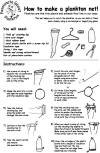 How
to make a plankton net! How
to make a plankton net!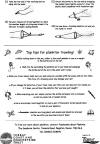
Objectives
-
To communicate to a wide and varied audience of beach users
and local residents the presence and importance of plankton in the marine
ecosystem and the nature of that ecosystem as a whole.
-
To promote the role of science in understanding and
protecting marine ecosystems.
Strategy
-
To use the Goodrington Seashore Centre in Paignton as a
springboard for a public awareness campaign.
-
To hold a programme of events, interactive workshops and boat
trips around the beaches and waters of Torbay throughout the holiday season.
-
To organise a similar programme of activities for the local
community throughout the year.
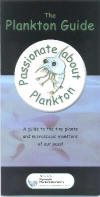 A
total of 3,859 members of the public participated in Passionate about Plankton
events during the second year of the project. A further 40,000 people visited
the Seashore Centre and Sea Zone during this time, with 70% of those using or
reading plankton related material. A
total of 3,859 members of the public participated in Passionate about Plankton
events during the second year of the project. A further 40,000 people visited
the Seashore Centre and Sea Zone during this time, with 70% of those using or
reading plankton related material.
A guide to the tiny plants and microscopic monsters of our
seas!
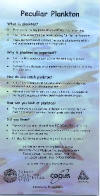 The
Guide gives a simple introduction to plankton and its importance in the marine
ecosystem with simple line drawings illustrating the common species of plankton
found in south-west waters. It was produced in full colour with a laminate
covering. This was considered essential due to the watery nature of plankton
identification, therefore extending the viable lifetime over which an individual
guide could be used. The
Guide gives a simple introduction to plankton and its importance in the marine
ecosystem with simple line drawings illustrating the common species of plankton
found in south-west waters. It was produced in full colour with a laminate
covering. This was considered essential due to the watery nature of plankton
identification, therefore extending the viable lifetime over which an individual
guide could be used.
The Plankton Guide was available to the general public free of charge, enabling
everybody who had an interest to access this information. The guide was made
available at the Seashore Centre and on all Passionate about Plankton events
carried out during this year. In addition to this, the project responded to
requests.
|